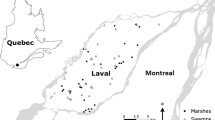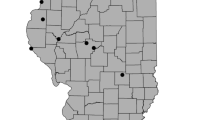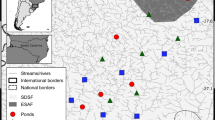Abstract
Context
Biotic homogenization (BH), the process by which β-diversity erodes, is suspected to be severe among plant communities due to widespread anthropogenic disturbances. However, few studies have directly linked anthropogenic disturbance with patterns of BH. The US National Wetlands Condition Assessment (NWCA) provides an opportunity to investigate patterns of β-diversity related to anthropogenic disturbances.
Objectives
Our objectives were to compare β-diversity between highly, intermediately and less-disturbed herbaceous emergent wetlands across the temperate region of the conterminous US, and to identify species with greatest influence on β-diversity patterns within disturbance categories.
Methods
Using species occurrence and abundance data, average distances to group centroids in ordination space were used to assess wetland β-diversity across a disturbance gradient. Species contributions to β-diversity were calculated per disturbance category.
Results
Compared to the least and intermediately disturbed wetlands, highly disturbed wetlands had significantly lower β-diversity based on species abundances across the study area. When using only species occurrences, highly disturbed wetlands had significantly lower β-diversity than intermediately disturbed wetlands. No significant differences were found amongst disturbance categories at the within-site scale. The invasive grass Phalaris arundinacea had the greatest influence on β-diversity, especially in the most disturbed wetlands.
Conclusions
Our results demonstrate that anthropogenic disturbances have homogenized regional botanical diversity. This homogenization is a function of disturbance intensity, which, after a threshold is crossed creates environmental conditions that lead to the local dominance of a single, widespread invader. This process is repeated across the region, scaling up to homogenize the flora of the entire region.



Similar content being viewed by others
Data accessibility
The data supporting the conclusions of this article have been archived and are available via the University of Illinois, Data Bank https://doi.org/10.13012/B2IDB-7128075_V1. Raw data used for analysis can be found at https://www.epa.gov/national-aquatic-resource-surveys/nwca.
References
Amezaga JM, Santamaria L, Green AJ (2002) Biotic wetland connectivity—supporting a new approach for wetland policy. Acta Oecol 23:213–222
Anderson MJ (2006) Distance-based tests for homogeneity of multivariate dispersions. Biometrics 62:245–253.
Anderson MJ, Crist TO, Chase JM, Vellend M, Inouye BD, Freestone AL, Sanders NJ, Cornell HV, Comita LS, Davis KF, Harrison SP, Kraft NJB, Stegen JC, Swenson NG (2011) Navigating the multiple meanings of beta diversity: a roadmap for the practicing ecologist. Ecol Lett 14:19–28
Bailey RG (2016) Bailey’s ecoregions and subregions of the United States, Puerto Rico, and the U.S. Virgin Islands. Forest Service Research Data Archive, Fort Collins
Capinha C, Essl F, Seebens H, Moser D, Pereira HM (2015) The dispersal of alien species redefines biogeography in the Anthropocene. Science 348:1248–1251
Cassey P, Lockwood JL, Blackburn TM, Olden JD (2007) Spatial scale and evolutionary history determine the degree of taxonomic homogenization across island bird assemblages. Divers Distrib 13:458–466
Cassey P, Lockwood JL, Olden JD, Blackburn TM (2008) The varying role of population abundance in structuring indices of biotic homogenization. J Biogeogr 35:884–892
Castro SA, Jaksic FM (2008) How general are global trends in biotic homogenization? Floristic tracking in Chile, South America. Glob Ecol Biogeogr 17:524–531
Chen H, Qian H, Spyreas G, Crossland M (2010) Native-exotic species richness relationships across spatial scales and biotic homogenization in wetland plant communities of Illinois, USA. Divers Distrib 16:737–743
Choi YD, Bury C (2003) Process of floristic degradation in urban, and suburban wetlands in northwestern Indiana, USA. Nat Area J 23:320–331
Clavero M, Garcia-Berthou E (2006) Homogenization dynamics and introduction routes of invasive freshwater fish in the Iberian Peninsula. Ecol Appl 16:2313–2324
Daga VS, Skora F, Padial AA, Abilhoa V, Gubiani EA, Vitule JRS (2015) Homogenization dynamics of the fish assemblages in Neotropical reservoirs: comparing the roles of introduced species and their vectors. Hydrobiologia 746:327–347
Dahl TE, Bergeson MT (2009) Technical procedures for conducting status and trends of the nation’s wetlands. US Fish and Wildlife Service, Division of Habitat and Resource Conservation, Washington, DC
Davey CM, Chamberlain DE, Newson SE, Noble DG, Johnston A (2012) Rise of the generalists: evidence for climate driven homogenization in avian communities. Glob Ecol Biogeogr 21:568–578
Deane DC, Fordham DA, Stevens AK, Bradshaw CJA (2017) Dispersal-driven homogenization of wetland vegetation revealed from local contributions to β-diversity. J Veg Sci 28:893–902
Dormann CF, Schweiger O, Augenstein I, Bailey D, Billeter R, de Blust G, DeFilippi R, Frenzel M, Hendrickx F, Herzog F, Klotz S, Liira J, Maelfait JP, Schmidt T, Speelmans M, van Wingerden WKRE, Zobel M (2007) Effects of landscape structure and land-use intensity on similarity of plant and animal communities. Global Ecol Biogeogr 16:774–787
Dray S, Bauman D, Blanchet Gl, Borcard D, Clappe S, Guenard G, Jombart T, Larocque G, Legendre P, Madi N, Wagner HH (2018) Adespatial: multivariate multiscale spatial analysis. R package version 0.3-2. https://cran.r-project.org/web/packages/adespatial/index.html
Finnoff D, Shogren JF, Leung B, Lodge D (2007) Take a risk: preferring prevention over control of biological invaders. Ecol Econ 62:216–222
Galatowitsch SM, Anderson NO, Ascher PD (1999) Invasiveness in wetland plants in temperate North America. Wetlands 19:733–755
Houlahan JE, Keddy PA, Makkay K, Findlay CS (2006) The effects of adjacent land use on wetland species richness and community composition. Wetlands 26:79–96
Huston MA (1999) Local processes and regional patterns: appropriate scales for understanding variation in the diversity of plants and animals. Oikos 86:393–401
Johnson AL, Tauzer EC, Swan CM (2015) Human legacies differentially organize functional and phylogenetic diversity of urban herbaceous plant communities at multiple spatial scales. Appl Veg Sci 18:513–527
Kercher SM, Zedler JB (2004) Multiple disturbances accelerate invasion of reed canary grass (Phalaris arundinacea L.) in a mesocosm study. Oecologia 138:455–464
Kercher SM, Carpenter QJ, Zedler JB (2004) Interrelationships of hydrologic disturbance, reed canary grass (Phalaris arundinacea L.), and native plants in Wisconsin wet meadows. Nat Area J 24:316–325
Kercher SM, Herr-Turoff A, Zedler JB (2007) Understanding invasion as a process: the case of Phalaris arundinacea in wet prairies. Biol Invasions 9:657–665
King RS, Richardson CJ, Urban DL, Romanowicz EA (2004) Spatial dependency of vegetation-environment linkages in an anthropogenically influenced wetland ecosystem. Ecosystems 7:75–97
La Sorte FA, McKinney ML (2007) Compositional changes over space and time along an occurrence-abundance continuum: anthropogenic homogenization of the North American avifauna. J Biogeogr 34:2159–2167
Legendre P, De Caceres M (2013) Beta diversity as the variance of community data: dissimilarity coefficients and partitioning. Ecol Lett 16:951–963
Leung B, Lodge DM, Finnoff D, Shogren JF, Lewis MA, Lamberti G (2002) An ounce of prevention or a pound of cure: bioeconomic risk analysis of invasive species. Proc R Soc B 269:2407–2413
Lopez RD, Davis CB, Fennessy MS (2002) Ecological relationships between landscape change and plant guilds in depressional wetlands. Landsc Ecol 17:43–56
Lougheed VL, McIntosh MD, Parker CA, Stevenson RJ (2008) Wetland degradation leads to homogenization of the biota at local and landscape scales. Freshw Biol 53:2402–2413
Martin LM, Wilsey BJ (2015) Differences in beta diversity between exotic and native grasslands vary with scale along a latitudinal gradient. Ecology 96:1042–1051
Marzloff MP, Little LR, Johnson CR (2016) Building resilience against climate-driven shifts in a temperate reef system: staying away from context-dependent ecological thresholds. Ecosystems 19:1–15
McKinney ML (2004) Measuring floristic homogenization by non-native plants in North America. Glob Ecol Biogeogr 13:47–53
McKinney ML, La Sorte FA (2007) Invasiveness and homogenization: synergism of wide dispersal and high local abundance. Glob Ecol Biogeogr 16:394–400
McKinney ML, Lockwood JL (1999) Biotic homogenization: a few winners replacing many losers in the next mass extinction. Trends Ecol Evol 14:450–453
Oksanen J, Blanchet FG, Friendly M, Kindt R, Legendre P, McGlinn D, Minchin PR, O’Hara RB, Simpson GL, Solymos P, Henry M, Stevens H, Szoecs E, Wagner H (2017) Vegan: community ecology package. R package version 2.4-4. https://CRAN.R-project.org/package=vegan
Olden JD (2006) Biotic homogenization: a new research agenda for conservation biogeography. J Biogeogr 33:2027–2039
Olden JD, Poff NL (2004) Ecological processes driving biotic homogenization: testing a mechanistic model using fish faunas. Ecology 85:1867–1875
Olden JD, Poff NL, Douglas MR, Douglas ME, Fausch KD (2004) Ecological and evolutionary consequences of biotic homogenization. Trends Ecol Evol 19:18–24
Olden JD, Poff NL, McKinney ML (2006) Forecasting faunal and floral homogenization associated with human population geography in North America. Biol Conserv 127:261–271
Powell KI, Chase JM, Knight TM (2013) Invasive plants have scale-dependent effects on diversity by altering species-area relationships. Science 339:316–318
Price EPF, Spyreas G, Matthews JW (2018) Biotic homogenization of regional wetland plant communities in the presence of an aggressive invader. J Ecol 106:1180–1190
Price EPF, Spyreas G, Matthews JW (2019) Wetland compensation and its impacts on β-diversity. Ecol Appl 29:e01827
Qian H, Guo Q (2010) Linking biotic homogenization to habitat type, invasiveness and growth form of naturalized alien plants in North America. Divers Distrib 16:119–125
Qian H, Ricklefs RE (2006) The role of exotic species in homogenizing the North American flora. Ecol Lett 9:1293–1298
R Core Team (2017) R: A language and environment for statistical computing. R Foundation for Statistical Computing, Vienna, Austria. https://www.R-project.org/
Rooney TP, Olden JD, Leach MK, Rogers DA (2007) Biotic homogenization and conservation prioritization. Biol Conserv 134:447–450
Santamaria L (2002) Why are most aquatic plants widely distributed? Dispersal, clonal growth and small-scale heterogeneity in a stressful environment. Acta Oecol 23:137–154
Schooler SS, McEvoy PB, Coombs EM (2006) Negative per capita effects of purple loosestrife and reed canary grass on plant diversity of wetland communities. Divers Distrib 12:351–363
Smart SM, Henrys PA, Purse BV, Murphy JM, Bailey MJ, Marrs RH (2012) Clarity or confusion?—Problems in attributing large-scale ecological changes to anthropogenic drivers. Ecol Indic 20:51–56
Socolar JB, Gilroy JJ, Kunin WE, Edwards DP (2016) How should beta-diversity inform biodiversity conservation? Trends Ecol Evol 31:67–80
Spyreas G, Wilm BW, Plocher AE, Ketzner DM, Matthews JW, Ellis JL, Heske EJ (2010) Biological consequences of invasion by reed canary grass (Phalaris arundinacea). Biol Invasions 12:1253–1267
Stevens DL, Olsen AR (2004) Spatially balanced sampling of natural resources. J Am Stat Assoc 99:262–278
Trentanovi G, von der Lippe M, Sitzia T, Ziechmann U, Kowarik I, Cierjacks A (2013) Biotic homogenization at the community scale: disentangling the roles of urbanization and plant invasion. Divers Distrib 19:738–748
US Environmental Protection Agency (2011) National Wetland Condition Assessment: Field Operations Manual. EPA Publication 843-R-10-001
US Environmental Protection Agency (2012) National Lakes Assessment 2012: A Collaborative Survey of Lakes in the United States. EPA Publication 841-R-16-113
US Environmental Protection Agency (2016a) National Wetland Condition Assessment: A collaborative survey of the nation’s wetlands. EPA Publication 843-R-15-005
US Environmental Protection Agency (2016b) National Wetland Condition Assessment: Technical report. EPA Publication 843-R-15-006. https://www.epa.gov/national-aquatic-resource-surveys/nwca
US Environmental Protection Agency (2016c) National Rivers and Streams Assessment 2008-2009: A Collborative Survey. EPA Publication 841-R-16-007
US Environmental Protection Agency (2016d) National Aquatic Resources Surveys. National Wetland Condition Assessment 2011 (data and metadatafiles). Available from US EPA website. http://www.epa.gov/national-aquatic-resource-surveys/data-national-aquatic-resource-surveys. Accessed 6 Jan 2017
Winter M, Schweiger O, Klotz S, Nentwig W, Andriopoulos P, Arianoutsou M, Basnou C, Delipetrou P, Didziulis V, Hejda M, Hulme P, Lambdon P, Pergl J, Pysek P, Roy DB, Ingolf K (2009) Plant extinctions and introductions lead to phylogenetic and taxonomic homogenization of the European flora. Proc Natl Acad Sci USA 106:21721–21725
Zedler JB (2003) Wetlands at your service: reducing impacts of agriculture at the watershed scale. Front Ecol Environ 1:65–72
Zedler JB (2009) Feedbacks that might sustain natural, invaded, and restored states in herbaceous wetlands. In: Hobbs RJ, Suding KN (eds) New models for ecosystem dynamics and restoration. Island Press, Washington, pp 236–258
Zedler JB, Kercher S (2004) Causes and consequences of invasive plants in wetlands: opportunities, opportunists, and outcomes. Crit Rev Plant Sci 23:431–452
Zedler JB, Kercher S (2005) Wetland resources: status, trends, ecosystem services, and restorability. Ann Rev Environ Resour 30:39–74
Zweig CL, Kitchens WM (2009) Multi-state succession in wetlands: a novel use of state and transition models. Ecology 90:1900–1909
Acknowledgements
This material is based upon work that was supported by Illinois Environmental Protection Agency grant FW-16201. This work would not have been possible without support from the Illinois Department of Natural Resources, Illinois Department of Transportation, and the United States Environmental Protection Agency. Special thanks to the many people who contributed to the NWCA dataset.
Author information
Authors and Affiliations
Corresponding author
Additional information
Publisher's Note
Springer Nature remains neutral with regard to jurisdictional claims in published maps and institutional affiliations.
Electronic supplementary material
Below is the link to the electronic supplementary material.
Rights and permissions
About this article
Cite this article
Price, E.P.F., Spyreas, G. & Matthews, J.W. Biotic homogenization of wetland vegetation in the conterminous United States driven by Phalaris arundinacea and anthropogenic disturbance. Landscape Ecol 35, 779–792 (2020). https://doi.org/10.1007/s10980-020-00978-x
Received:
Accepted:
Published:
Issue Date:
DOI: https://doi.org/10.1007/s10980-020-00978-x




